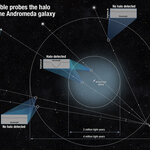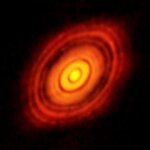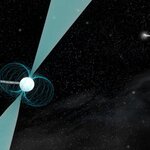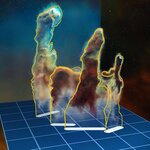Space
This is a question which was asked recently on quora: Is it possible to have a moon so reflective that when it reflects the light of the sun, it will be as if it is daylight? Anyway it is a rather fun problem, easy to work out by "back of the envelope calculations", and the answer takes us to some interesting areas of planetary physics.
First it would be easy to arrange for this by mega engineering if we had a Moon as big as our Earth. Cover the near hemisphere with mirrors and angle the mirrors so that they reflect almost all the sunlight received on that hemisphere towards the Earth at…

So, you think you know what a planet looks like? A sphere, perhaps flattened at the poles? But if you've been following recent discoveries of dwarf planets, you may know that rapidly spinning dwarf planets like Haumea typically are rugby ball shaped (triaxial spheroids), rather surprisingly perhaps. So, what other shapes can a planet have? Theory, and experiment with droplets in simulated zero g suggest several exotic possibilities.
In Hal Clement's classic hard science fiction novel Mission of Gravity his explorers discover a rapidly spinning planet, and naturally enough he…

The Andromeda galaxy is our nearest galactic neighbor in space. Though it is 2.5 million light-years away, its spiral of over 100 billion stars makes it visible as a cigar-shaped smudge of light high in the autumn sky.
But there is also something that takes Hubble to notice - a huge bubble of hot, diffuse plasma surrounding it. If we could see that gargantuan halo from Earth, it would appear to be 100 times the angular diameter of the full Moon.
The gargantuan halo can be thought of as the "atmosphere" of a galaxy and is estimated to contain half the mass of the stars in the Andromeda…

A recent and famous image of HL Tau in deep space marks the first time we've seen a forming planetary system, according to a team of astrophysicists who found that circular gaps in a disk of dust and gas swirling around the young star HL Tau are in fact made by forming planets.
The image of HL Tau, taken in October 2014 by the state-of-the-art Atacama Large Millimeter/submillimeter Array (ALMA) located in Chile's Atacama Desert, sparked a flurry of scientific debate.
The HL Tau system is less than a million years old, about 17.9 billion kilometres in radius and resides 450 light years from…

Astronomers have reported an exceptionally luminous galaxy from when the universe was only 5% of its present age - more than 13 billion years in the past.
The galaxy, EGS-zs8-1, was originally identified based on its particular colors in images from NASA's Hubble and Spitzer telescopes and the team determined its exact distance from Earth using the powerful MOSFIRE instrument on the W.M. Keck Observatory's 10-meter telescope in Hawaii. It is the most distant galaxy currently measured and one of the brightest and most massive objects in the early universe.
Age and distance are vital…

Italy, one of the key players of the European Space Agency (ESA), is continuously building up its important role in human spaceflight and in international space cooperation.
The country of seven astronauts is shaping the future of Europe’s next generation launch vehicles and is actively taking part in ESA’s space exploration projects. In an interview with me, Italian Space Agency (ASI) President Roberto Battiston, talks his presidency and Italy’s contribution to spaceflight.
Are you proud of Italian astronauts in space, especially the latest missions of Luca Parmitano and Samantha…

A team of high school students analyzed data from the National Science Foundation's (NSF) Robert C. Byrd Green Bank Telescope (GBT) and discovered a never-before-seen pulsar which has the widest orbit of any around a neutron star - one among only a handful of double neutron star systems.
Pulsars are rapidly spinning neutron stars, the superdense remains of massive stars that have exploded as supernovas. As a pulsar spins, lighthouse-like beams of radio waves, streaming from the poles of its powerful magnetic field, sweep through space.
When one of these beams sweeps across the Earth,…
Draft of my presentation for the think tank this summer on the value to science and implications of exploration of Enceladus and Europa for signs of life.
This talk is about the science value and implications of searching for life in the oceans of Europa and Enceladus.
Enceladus particularly is such an interesting place for exobiology, especially with the new results published in March of this year.
As well as that it gives us a wonderful opportunity to search for life with the minimal of planetary protection issues, which is an issue close to my…
This is a draft of my presentation for the think tank this summer on exploration of Enceladus and Europa for signs of life.
My background is in maths, philosophy and logic. So I wonder a bit what I am doing talking about astrobiology? Of course I'm interested in the subject as an amateur. It started when I wrote a couple of articles for my science blog on "Need for Caution for a Mars Sample Return" and "Ten reasons not to Live on Mars, Great Place to Explore". From which you can see that I don't hesitate about speaking my mind on controversial topics in the…

The original NASA/ESA Hubble Space Telescope image of the famous Pillars of Creation - in the Eagle Nebula, Messier 16 - was taken two decades ago and immediately became its most famous picture. Since then, these billowing clouds, which extend over a few light-years, have awed the public.
Using the MUSE instrument on ESO's Very Large Telescope (VLT), astronomers have produced the first complete three-dimensional view of these famous Pillars. The new observations demonstrate how the different dusty pillars of this iconic object are distributed in space and reveal many new details --…